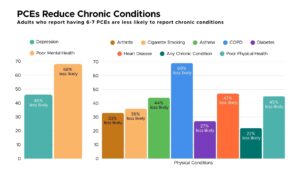
Collecting BRFSS data in Kansas, Montana, South Carolina, and Wisconsin
The HOPE National Resource Center, in collaboration with the Centers for Disease Control and Prevention (CDC), Prevent Child Abuse America, Johns Hopkins, and Boston University, recently published a new paper in JAMA Network Open entitled “Positive Childhood Experiences and Adult Health and Opportunity Outcomes in 4 US States.”
The research team analyzed data from the Behavioral Risk Factor Surveillance Survey (BRFSS), a national telephone survey of health behaviors, conditions, and services. We used data from Kansas, Montana, South Carolina, and Wisconsin because these states included 7 questions on positive childhood experiences (PCEs). The survey participants were asked if they remembered any of the 7 PCEs growing up. They were also asked about their current mental and physical health conditions.
Research shows PCEs linked to health and economic benefits
We looked into whether the reported number of PCEs was associated with a lower risk of physical and mental health conditions, as well as a higher likelihood of life opportunities. We also wanted to determine the economic value of these lower health risks and increased life opportunities.
Physical health outcomes
Experiencing any number (1-7) of PCEs was associated with a lower risk of:
- Arthritis
- Asthma
- Cancer
- COPD (chronic obstructive pulmonary disease)
- Diabetes
- Heart disease
- Overweight or obesity
- Poor general physical health
Key finding: Adults who reported a high number of PCEs (6-7) were 27% less likely to report diabetes and 47% less likely to report heart disease than adults who reported 0 PCEs.
Mental health outcomes
Experiencing any number of PCEs was associated with a lower risk of:
- Depression
- Poor general mental health
Key finding: Adults who reported a high number of PCEs (6-7) were 68% less likely to report depression
Life Opportunities
Experiencing any number of PCEs was associated with a higher likelihood of:
- Attending or graduating from college
- Having an income of $50,000 or more
Key finding: Adults who reported a high number of PCEs (6-7) were 64% more likely to report attending or graduating from college and 117% more likely to report an income of $50,000 or more.
Economic impact of PCEs
Based on these associations with PCEs, we estimated how much money PCEs saved in preventing these health conditions. The estimated annual economic value was nearly $216 billion in the four states. This includes $3.1 billion in lower medical spending costs and $212.8 billion in additional healthy life years (years not lost due to disability, ill health, or early death), among adults with 3 or more PCEs.
For each adult, PCEs saved an estimated $28,000 every year, or $782,000 over their lifetime.
Why this research is important and how it impacts our work with PCEs
Our research provides crucial insight into the importance of PCEs and supports expanding the policies and programs that promote PCEs for more children and their families. This data can be used to better advocate for the wider use of PCEs in many settings, changing our systems for the better. In the future, we hope to have larger data sets to continue investigating the health benefits of PCEs.



